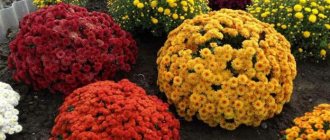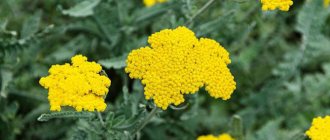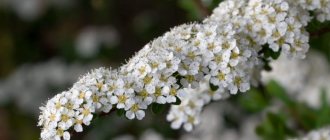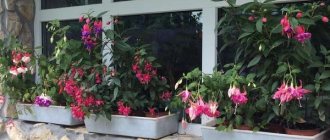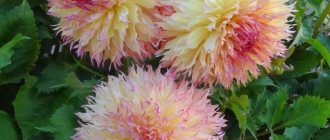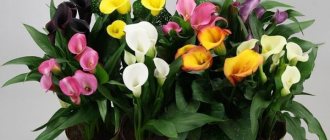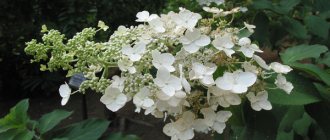Chamomile is a flower that can be kept in almost every garden plot. They love it for its variety of colors, ease of care, and decoration of landscape design. It belongs to the Astrov family. Large daisies, depending on the variety, can grow up to 1 meter in height. The stem is strong, rich green, slightly rough. The leaves growing along the length of the stem have a smooth texture, glossy, with dark green veins. The petals are arranged in several rows around a yellow center. The flower itself can reach 15 cm in diameter. The plant pleases the gardener with long-lasting flowering. It begins in the first ten days of June, and ends in the last ten days of September.
Chamomile is a plant that has grown exclusively in the wild for a very long time. Only 200 years ago did gardeners become interested in it for growing in gardens and personal plots. From the moment garden chamomile became widespread among flower growers, breeders began working on creating new varieties. Today there are a huge number of varieties of this already decorative plant. All varieties have many common features.
Ornamental varieties have already surpassed their wild relatives in terms of performance. They have a larger flower diameter, are taller, have a variety of colors, etc. But chamomile cannot be confused with another flower. Its middle consists of small tubular flowers, and along the diameter of the central part there are false-ligulate petals.
Garden chamomile
There are many more flowers that belong to the Asteraceae family. They are somewhat similar to each other. What are the names of flowers that look like large daisies? For example, gerberas. The name itself, large daisies, means Roman. The scientific name of this flower, derived from the Latin matrix, means uterus.
Botanical description
The name of the flower in Latin is “Camomille Matricaria”, the family to which chamomile belongs is Asteraceae or Asteraceae, class Dicotyledons. Common Chamomile has the following botanical description:
- stem - straight, branches into several branches at the base, stem height 15-50 cm;
- the root system is taproot, penetration depth into the soil is up to 50 cm;
- the leaves are lanceolate-shaped, divided into lobes, the color of the leaf blades varies from light tones to richly dark shades of green;
- inflorescences are represented by a hemispherical basket, the receptacle is conical;
- the baskets are composed of false-lingulate flowers of yellow and white color;
- The fruit of the plant is an oblong achene with no tuft.
Chamomile is a perennial plant, native to South Africa, Eurasia and America.
The Latin name "Matricaria", which translates as "uterus", was given to chamomile because it was used to treat diseases of the female reproductive system, especially to treat pathologies of the uterus.
The most popular varieties of cornflower
Or nivnyak, popovnik, garden chamomile, scientifically Leucanthemum vulgare. This is a whole genus of plants, consisting of more than 20 species. These daisies are tall (from 15 to 60 cm) and slender, have flowers with a diameter of 2.5 to 6 cm, with white petals along the edges and a yellow “basket” inside. They are bisexual (can pollinate themselves).
This genus has been cultivated since 1500. It has many flower subspecies.
Broadway Lights
The original cornflowers are pale yellow in color.
Goldrush
Another lemon flowers with thin petals running in several rows. The bushes are low (about 50 cm), flowers are up to 10 cm in diameter.
Edelweiss
Semi-double flowers with double rows of white petals: some are long and straight, moderately wide; others (near the core) are small, rounded. The choice of people who prefer everything original.
Maxima Koenig
blooming chamomile
The sizes are the same. The center is dark yellow, white petals are in two rows.
May Queen
Height 50 cm, glossy leaves, creeping along the ground.
Rizhskaya
????
Large (up to 16 cm in diameter) semi-double flowers, white petals are thin, of different shapes.
Real nit
Another original chamomile. Its peculiarity is that the white petals, growing in several rows, are wider at the ends than at the base.
Old court
The flower looks like a white “skinny” chrysanthemum. White petals are thin and straight. Semidouble.
Sans Souci
About a meter in height and up to 12 cm in flower diameter. The yellow center is small, white petals are arranged in several rows.
Silver Spoons (silver spoons)
A species very similar to real nit, however, the petals of such flowers are rather wide than narrow.
Snow Maiden
Interesting “chrysanthemums” with thin petals, very fluffy in appearance, when completely bloomed the yellow center is practically invisible (it is filled with white petals).
Ostrich feather
It looks like an old court, only the petals curl slightly.
Fiona Coghill
The most lush and terry version of the cornflower. The center is slightly yellow, surrounded by a mass of white petals of different sizes, running in many rows. The flowers are relatively small, their diameter is only 7, maximum 8 cm.
the greatest variety of perennial decorative chamomile is considered to be a very successful variety . This is a perennial plant with a height of 50 to 100 cm, with spatulate leaves, flowers with a diameter of about 11 cm, the white petals of which are arranged in 2 rows. This garden crop has been grown since 1816.
Moreover, this variety also has several subspecies. Among them there are also double flowers with many white, slightly curled marginal petals - the central parts of such flowers are white, so many people confuse them with chrysanthemums.
Alaska
Classic white daisy-like flowers with long white petals and shallow centers.
Beethoven
Chamomiles, which are distinguished by abundant flowering and low “growth” (about half a meter).
Victoria's Secret
A beautiful plant with slightly double flowers.
Little Princess
Neat daisies, seemingly simple, but at the same time exquisite.
And finally, there are several more species of nevus growing in the wild. This:
- Kuril nivet (it can be found on the Kuril Islands or the island of Hokkaido; this white flower differs from its fellows in its small size and unusual shape of leaves),
- swamp cornflower (an inhabitant of Portugal and Spain, a low plant with palmate leaves and small flowers up to 2 cm in diameter, in which the white petals are short and the central yellow part is large).
Of course, the so-called terry daisies deserve special attention. Is it difficult to grow these “snowflakes” in our conditions, are they whimsical? You will learn about this from the video:
Flower varieties
There are more than 300 varieties of chamomile, but the most famous are the following types:
- cornflower;
- echinacea;
- autumn helenium;
- gaillardia spinosa;
- doronicum yellow;
- small petal.
Other varieties of the flower are Persian, Caucasian, German, Roman. Unlike wild daisies, decorative varieties of the flower are characterized by color diversity. Varietal daisies can be red, yellow and blue, lilac and orange. The height of their stem reaches from 60 to 100 cm.
What kind of daisies there are depends on their variety; they are not only white, but also red, yellow, purple
Landing - rules and features
Planting a flower can be done either by seedlings or through seeds. The seedling method is preferred as it is more reliable.
With the seed method, seeds can be planted directly in open ground.
Rules and features of chamomile seedling planting:
- Planting time is March.
- Preparing seeds - 3 weeks - 1 month before planting in the ground, the seeds are placed in the refrigerator on the bottom shelf. Stratification will make the planting material stronger, reducing its sensitivity to diseases and pests.
- Containers - a tray divided into cells.
- The soil is light, containing 1 part sand and peat.
- Several seeds are dropped into one cell.
- The seeds are covered with a thin layer of nutritious soil mixture on top.
- The container is covered with a loose, transparent film and placed near the windowsill.
- The soil is moistened from the sprayer as it dries.
It is better to immediately plant chamomile in separate containers.
It is recommended to immediately place the seedlings in separate containers, so as not to have to thin them later, as there is a risk of damage to the root system.
You cannot place a container with seeds directly on the windowsill. When exposed to direct sunlight, seeds will germinate less easily and young shoots may develop sunburn.
Instructions for caring for planted seeds and seedlings:
- At room temperature, the first seedlings will appear in about 2 weeks.
- Immediately after the sprouts appear, the film is removed from the container and the container is placed in a well-lit place, the main thing is that there are no drafts there.
- If it is not possible to provide abundant sunlight, you can use fluorescent lamps. Daylight hours are 14 hours.
- Thinning of seedlings occurs when seedlings reach 5 cm in height. The essence of thinning is to leave only one, the strongest seedling in each cell.
- To make the seedlings more spread out, pinching is done over the 3rd leaf plate, this will promote the growth of lateral stems.
When thinning, seedlings should not be pulled out of the ground, as this can damage the roots of neighboring shoots. It is recommended to break off the seedling above the soil.
When to sow garden chamomile in open ground
If you sow from the end of March to the beginning of May, the sprouts will sprout within half a month. By the end of summer, the bushes will get stronger and bloom next season. If you sow cornflower in late autumn, then seedlings can be observed in the spring, buds will begin to form in the summer.
Step by step sowing:
- Place the seeds 2 cm deep into the substrate.
- Between rows 0.2-0.3 m.
- Water, making sure that the liquid does not stagnate.
- After the emergence of seedlings, they carefully break through so that there is 9-15 cm between the seedlings.
- If it is a pity to throw away the torn bushes, they are replanted. Even small sprouts take root well in moist soil mixture.
- The grown seedlings are planted at 0.4-0.5 m.
With proper care, cornflower grows quickly.
Growing a flower and further caring for it
Chamomile flowers are transplanted into open ground no earlier than 30-45 days after emergence. A prerequisite for transplantation is the absence of frost.
To plant chamomile flowers, you need to choose a well-lit area, without drafts. Suitable soil is limestone or neutral. Groundwater must lie deep.
The description of field chamomile speaks of the unpretentiousness of the flower, and therefore it can be planted not only in the ground, but also left in a pot
Planting a chamomile flower in open ground:
- Preparing the site includes digging it up and applying complex fertilizer intended for flowers.
- The depth of the holes is from 20 to 30 cm. The distance between the holes is at least 40 cm.
- The seedlings are taken out of the container with a lump of earth on the roots, carefully moved into the prepared holes, and covered with earth on top.
- The soil is lightly compacted and watered.
The depth of the holes and the distance between them must be selected depending on the type of flower.
When daisies grow, they need to be provided with proper care, which includes the following factors:
- Watering is systematic for the first 2-3 weeks, until the daisies take root. You cannot overfill the soil. The frequency of watering depends on how quickly the soil dries out. When the daisies take root, watering is reduced and is carried out only during prolonged drought.
- Mulching - carried out after watering, the recommended material is peat.
- Loosening the soil is a mandatory procedure and is performed after each watering.
- Fertilizer - applied every year. The nutrient substrate consists of peat, humus and compost, which are mixed with the soil. In the spring, ammonium nitrate is scattered under each bush in a dosage of 20 grams per 1 m².
- During the formation of buds, under flowers that are distinguished by lethargy and pale leaf blades, it is recommended to apply a urea solution.
- In autumn, slaked lime or dolomite flour is added to highly acidic soil.
After applying saltpeter under the bush, there is no need to water the plant.
The bushes must be prepared for wintering, because what is chamomile? It is a heat-loving flower. Before the onset of frost, the above-ground part of the bushes is completely cut off, then they are covered with dry leaves or sawdust.
In regions with severe frosts, it is recommended to cover daisies with non-woven materials.
Types of true daisies of the genus Matricaria
Only plants that belong to the genus Matricaria are considered true daisies. In total there are 25 species. The most common among them are chamomile or peeled, green or fragrant, rock, golden and western. Less known are varieties such as Matricaria tchihatchewii, Matricaria grossheimii, Sevan, subpolar and some others.
A characteristic feature of species of this genus is the presence of an empty cavity in the receptacle, which is not found in other similar plants. By this cavity, true daisies can be distinguished from any other plants whose inflorescences are similar in appearance.
The photo below shows a chamomile inflorescence dissected in a vertical plane:
Externally, these flowers are practically indistinguishable, but the cavity inside the receptacle allows them to be accurately identified. Most plants of the same species have quite a lot in common, but if you know their characteristic differences, it will not be so difficult to distinguish them:
- Chamomile (Matricaria chamomilla), which is also called medicinal and peeled, is an annual plant that has an erect, branched at the base, stem ranging from 20 to 60 cm in height. The diameter of the flower baskets is about 25 mm or 2.5 cm. They consist of 12-18 reed flowers forming the outer row, and multiple tubular flowers located in the middle on the receptacle. It is widespread in all regions of Europe, Asia and North America, and is also grown for industrial purposes in Siberia and Transbaikalia;
- Western chamomile (Matricaria occidentalis) also has external similarities with the two previous species. However, its stems can reach a height of 70 cm, and the inflorescences are practically odorless. It grows only in the north of America;
Different types of daisies can be quite similar in appearance. There are also plants belonging to other genera, but very similar to representatives of Matricaria. This must be taken into account if you plan to use the plant for medicinal purposes - when collecting raw materials from nature, you can accidentally pick another plant instead of chamomile. In pharmacology, chamomile and green chamomile are most often used.
Reproduction methods
Decorative daisies reproduce in two ways - by seeds and by dividing the bush.
Bush dividing method:
- The procedure is carried out at the end of September - the first week of October, always on a cool and cloudy day.
- One part with the root system is separated from the mother bush and transplanted into a previously prepared hole. Before planting, the hole is watered with settled or rainwater. Side shoots should be cut with a clean, disinfected tool.
- The hole with the cut part is filled with a nutritious soil mixture, which is then lightly compacted.
When propagating by division, only the healthy, young and strongest shoots are cut off. Next year, shoots from the opposite side will need to be cut off from the same mother bush.
Growing daisies in the same place is allowed for no more than 5 years, then the location for the flowers needs to be changed, otherwise they will begin to weaken and may stop blooming.
Propagation of a flower by seed means the correct collection of seed material, with its further use for seedlings:
- Seeds are collected from completely dried flowers. The flowers are cut and left in a dry place with good ventilation.
- The seed material is contained in tubular flowers, from which it is hatched when the daisies are completely dry.
- The seeds are winnowed and stored in a paper bag.
The use of collected seeds for seedlings is possible for several years. Seeds can be immediately planted in open ground.
Sometimes chamomile is planted before winter
Planting can be done even before winter - the seed will not freeze, but on the contrary, it will undergo stratification, making future plants stronger.
Only ordinary chamomiles can be propagated by seeds. Varietal and double representatives of the plant do not retain parental characteristics in the seeds.
How to plant this plant?
From seeds
They can be sown directly into the ground. This is done at the end of May, when there are no longer frosts at night. The seeds are scattered thickly over the fluffy bed, and at the end they are also dusted with earth.
When the sprouted flowers have about 3 pairs of leaves (real ones), the excess stems can be plucked off. Be careful, they are still very tender now - because of this, you even need to water them carefully.
Seedling method
He is considered the most successful. In March, seeds are purchased (if they were not selected in advance from the flower garden), a tray with cells and soil, for example, peat with sand. Up to three seeds are placed in each cell and lightly dusted with soil. The top of the tray is covered with film, the tray is placed near the window, but not on the windowsill (the sprouts will not like a large amount of sun). They should not be watered directly, but from a spray bottle.
The seeds will germinate in about two weeks. Now you can remove the film and move the tray even closer to the light (most importantly, do not open the window - the sprouts are afraid of a draft). When the seedlings grow to 5 cm, carefully pinch off the weakest “brothers”, leaving 1 sprout per cell (do not pull them out, otherwise it will harm the stronger sprout).
Sprouts can be transplanted into a flower garden a month, or even a month and a half after germination. The main thing is that it is already warm outside, and frost does not return at night.
Important: this “baby” will bloom next year!
Dividing the bush
2-3 years after planting, the daisy bush grows, after which it becomes as if empty inside (the central stem dries out first). Therefore, such a bush can no longer be regretted. In the spring it is dug up and divided into several smaller bushes - the so-called divisions.
After this, dig a hole at least 20 cm deep for each (if there are problems with the soil on your site, pour a little fertile soil inside each hole). The distance between the holes is up to 40 cm (by the way, maintain the same distance when planting seedlings). “Place” the bushes inside, press them with earth and water them. Ready!
Diseases and pests - methods of combating them
Diseases to which chamomiles are susceptible if not properly cared for:
- Fusarium is a fungus that causes root rot. Signs - tissues become brown, shoots become thinner and weaker.
- Powdery mildew is the appearance of a white coating on a flower, which gradually becomes brown.
- Gray rot is the formation of brown spots on leaf blades that rapidly increase in size. Gradually, the leaf part of the plant turns completely yellow.
- Rust is the appearance of dark yellow, dense spots on the foliage.
To treat chamomile diseases, fungicides are used - Kuproxat, Oxychom, Fundazol.
Preventing the occurrence of diseases - following the rules of watering, without waterlogging the soil, timely loosening the soil and weeding.
Insects:
- thrips, aphids - the appearance of light yellow spots on the leaf blades, the gradual death of the soft tissues of the plant;
- wireworms - damage the root system, leading to the death of the entire bush;
- star-winged fly - accumulates on the middle flowers, sucking the juices from the plant.
Insecticides are used to get rid of insects. Measures to prevent the appearance of parasites include proper plant care, timely removal of weeds, preventive treatment with insecticides, otherwise the flower will not be able to grow strong and beautiful.
Diseases must be combated immediately when the first signs appear, otherwise the chamomile bush will quickly die
Useful properties of the plant, contraindications for use
Chamomile has a number of beneficial properties, which is why it has long been used not only as a traditional medicine, but also as a natural component of many medicines.
Medicinal effects of the plant:
- choleretic;
- hemostatic;
- anti-inflammatory;
- antibacterial;
- diuretic;
- soothing;
- antispasmodic.
Chamomile flowers contain tannins, macro- and microelements, vitamins, so simple tea made from it has a beneficial effect on the immune system, strengthening the body's defenses.
Taking chamomile has contraindications:
- stomach ulcer;
- acute diseases of the genitourinary system;
- psychical deviations;
- frequent diarrhea.
There may be an allergic reaction to chamomile and its chemical components caused by individual intolerance.
Where do daisies grow?
Chamomiles have very small seeds that are easily blown by the wind over long distances, so glades or individual bushes of these flowers can be seen in almost any area of the world. Unpretentiousness and the ability to adapt to any conditions play a key role in the widespread distribution of these plants.
These flowers can be found throughout the Eurasian continent, in Australia, southern Africa and America. Wild daisies are frequent companions of roadsides, bright sunny meadows and foothills. In addition, representatives of the Astrovs have long charmed gardeners with their beauty and ease of care.
Usage
The main areas of use of chamomile are cosmetology and medicine. In medicine, the flower is used in the following cases:
- menstrual irregularities;
- flatulence;
- spasms;
- internal inflammatory processes;
- dermatological diseases.
Chamomile disinfects and has a disinfectant; it is added to baths for bathing babies.
Decoctions and lotions based on the plant are used in cosmetology as restorative agents for hair, for wiping the skin with acne, inflammation and acne.
